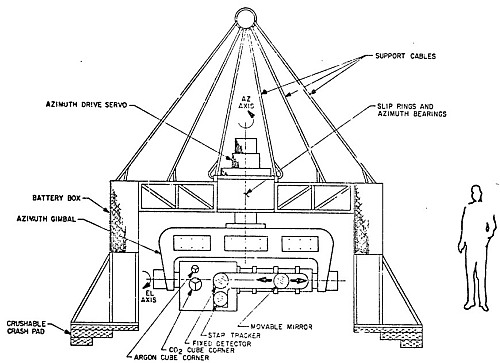Purpose of the flight and payload description
The BAPE experiment were a series of balloon flights aimed to investigate the propagation of laser beams from the ground level to 28 km. A ground-based laser tracking system developed by NASA/GSFC projected Argon and CO2 laser beams toward a balloon-borne optical receiver system.
The balloon-borne receiver system included two argon receivers and two HgCdTe CO2 receivers. A laser tracker and servosystem kept the receivers and a 1 inch diameter retroreflector pointed towards the ground station during data collection periods.
Separation of the argon and CO2 detectors was varied from 2 to 82 cm. Data from each receiver channel was telemetered to the ground station and recorded. Ambient pressure and temperature, azimuth and elevation bearings, tracking error signals, and other experiment control data were also telemetered to the ground station. The balloon-borne instrumentation and the complete telemetry system was developed by GTE Sylvania.
Details of the balloon flight
Balloon launched on: 9/9/1971
Launch site: Holloman Air Force Base, Alamogordo, New Mexico, US
Balloon launched by: Air Force Cambridge Research Laboratories (AFCRL)
Balloon manufacturer/size/composition: Zero Pressure Balloon
End of flight (L for landing time, W for last contact, otherwise termination time): 9/9/1971
External references
- Correlation of Microthermal Turbulence Data with Meteorological Soundings in the Troposphere Journal of the Atmospheric Sciences 1973 30:1, 83-87
- Measurements of Turbulence Profiles in the Troposphere Journal of the Optical Society of America Vol. 62, Issue 9, pp. 1068-1070 (1972)
- The BAPE 2 balloon-borne CO2 Technical Report - NASA Goddard Space Flight Center; Greenbelt, MD, United States (1972)
7878If you consider this website interesting or useful, you can help me to keep it up and running with a small donation to cover the operational costs. Just the equivalent of the price of a cup of coffee helps a lot.


